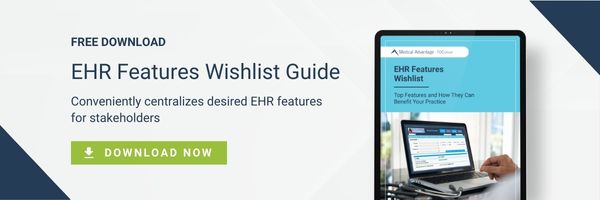1. Identify Your Practice’s EHR System Needs
2. Prioritize Ease-of-Use for Staff with the Help of EHR Vendors
3. Discuss Full Integration to Attain EHR System Benefits
4. Consider the Cost of EHR Implementation
EHR System Selection: Creating an EHR Vendor Comparison
Selecting a suitable Electronic Health Records (EHR) system is one of the single most important decisions a medical practice or organization can make. While EHR system selection is far from easy, taking the time to evaluate the types of EHR systems and compare vendors is crucial for return on investment in the long run.
How Do I Choose The Best EHR For My Practice
So, how does one select an EHR for a medical practice or organization? When doing so, there are several factors to consider:
- your practice’s individual needs and workflows
- prioritization of staff’s ease of use,
- your practices’ IT infrastructure and integration capabilities
- your practice’s data and analytics needs, and
- the cost of implementing a new EHR system.
Each of these factors is an important consideration during the process of EHR system selection. Regardless of which type of EHR system your organization ultimately chooses, considering these attributes during – and not after – your EHR vendor selection will go a long way toward ensuring a successful rollout, practice integration, and return on investment.
1. Identify Your Practice’s EHR System Needs
The first step in any EHR system selection process is to take stock of what you know best – the needs of your practice or organization. From data stored, to workflows used, to services performed, and to payers and groups operated within, each organization is unique and has unique needs. When making EHR vendor comparisons, make sure to select an EHR that will work with those needs – not against them.
Consider the particular needs of your practice before, and not after you select an EHR vendor.
Considering the services rendered at the practice and the patient data stored within the system is a good starting point when selecting an EHR system. What sort of practice do you have – primary care, specialty, FQHC, or another type of organization entirely? Because each setting provides different services and has varied patient populations, it is not one-size-fits-all when it comes to EHR systems.
Next, think about the broader framework within which your practice operates.
- Are you part of a larger group, such as a PO or ACO?
- Are you involved in any value-based care contracts with payers?
- Is your practice multi-location?
If you answered yes to any of these questions, you would want to consider those EHR systems with strong standardization capabilities. Additionally, if you participate in agreements in which certain population metrics are required for reimbursement, make sure your EHR vendor has robust tracking capabilities for those particular metrics.
Finally, consider any other medical technology your practice uses (or may want to eventually use) during care delivery. Are patients given Remote Patient Monitoring (RPM) devices? Is telehealth a large part of your operations? If these things are currently part of your plan (or might be in the future) make sure your EHR system selection process takes this into account. Be sure to prioritize types of EHR systems with RPM, telehealth, and other technology integration capabilities.
2. Prioritize Ease-of-Use for Staff with the Help of EHR Vendors
One thing should be kept top-of-mind when making any EHR vendor selection – levels of healthcare worker burnout and dissatisfaction in the United States are currently at some of the highest-recorded numbers. Why is this an important consideration when selecting EHR vendors? Because a badly-executed EHR rollout (or just a poor EHR vendor selection) can increase staff dissatisfaction – and may leave practice managers putting up “Now Hiring” signs.
Prioritizing ease-of-use for your staff is, then, one of the most important steps to take when making an EHR system selection. How can this be done? First of all, take stock of who your staff is, and how they work.
Collect feedback from staff – communicate with them about what is and is not working under the current system before you implement changes. Involve staff in the selection process and ask them what features would they like, and what saves them time. Conversely, ask them what features they do not like under the current system and use this feedback when considering new EHR systems.
Healthcare worker burnout and job dissatisfaction is on the rise, and an EHR system that works better for your staff may be the solution.
Once you have made your EHR vendor selection, take the time to carefully plan a rollout that ensures maximum success. Consider running training sessions, recruiting consultants, or posting information in the building to make implementation as easy as possible.
Remember, while implementing a new EHR system will save time and money down the line, staff buy-in during the early stages is crucial. Communicate with and listen to staff needs before, during, and after the EHR system selection process to position your practice for success.
3. Discuss Full Integration to Attain EHR System Benefits
While your EHR is one of the most central pieces of your practice workflow it is, of course, not the only one. Also fundamental for many medical organizations are systems for billing, revenue cycle management, HR, finance, analytics, telehealth, remote patient management, and more. For maximum return on investment and minimal headaches, EHR systems need to be able to “communicate” and interface with these other systems.
For this reason, any consideration of an EHR vendor must take into account how well a given EHR system can integrate with the rest of the practice’s data and workflows. Doing so will have significant benefits for both patient and provider – as more data factored within the system drives better care outcomes up while driving the cost down. But for this to occur, the right EHR vendor must be used – as each practice, organization, and specialty has unique data types, workflows, and needs.
In addition, having an EHR that integrates well helps your organization avoid data silos. “Data silo” refers to a situation in which data or information is “siloed” or only accessible in one location. Aside from causing frustration and increased labor, data silos prevent the smooth flow of data and can consequently negatively affect both patient outcomes and reimbursements.
In short, considering the full scope of practice operations and data systems is paramount when choosing between types of EHR systems.
4. Consider the Cost of EHR Implementation
Of course, any EHR system selection process is going to hinge largely upon one of the most principal factors: cost. And while acquiring an EHR software license for your organization can be expensive, it is only the start of expenses incurred from a new EHR transition – although proper management can mitigate these costs.
Outside of the “price tag” of the EHR, practices should also consider the cost of setup and implementation. Will there be any downtime for training and rollout as the EHR is implemented? This can lead to lost revenues. Will IT consultants need to be brought in to install the EHR and integrate it with other software systems?
Further, the introduction of almost any new EHR system is going to require some sessions for staff to be trained for the new workflow. Hiring EHR consultants to assist with this will come at an extra cost, although this cost will, of course, be offset by the long-term savings experienced from this large investment.
This point bears repeating: implementing a new EHR system is an investment. Like any investment, proper planning, and management, in the beginning, is crucial for saving time, money, and frustration down the road. While some of these steps can be complex, they are each necessary to maximize the chance of success for a new EHR rollout.
EHR System Selection: Creating an EHR Vendor Comparison
With these four considerations in place, it is time to begin comparing eligible vendors against the criteria.
- Does it meet your practice’s individual needs and workflows?
- Does it promote ease of use for staff?
- Will the EHR system integrate well with your practice’s IT systems?
- Have all the costs – both the direct and associated expansion of the new EHR system – been accounted for?
Don’t rush the process – take your time and communicate with stakeholders before making a decision – this is a huge investment that will have big ramifications on your practice
Medical Advantage Can Help
Comparing, selecting, and implementing EHR systems is one of the most important things a practice can do for clinical and financial success – but it is also one of the most difficult. Medical Advantage’s EHR consultants have been helping medical organizations navigate the EHR selection and implementation process for decades and with a track record of success.
Our consultants work alongside clients both virtually and at the point of care to understand their practice’s needs, make recommendations, and assist throughout the process both before, during, and after go-live. To find out more, or for a free consultation, contact one of our EHR consultants today.






